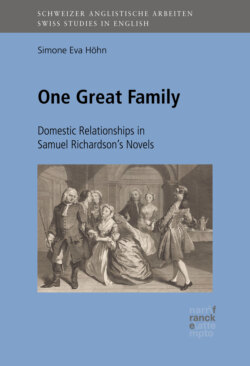One Great Family: Domestic Relationships in Samuel Richardson's Novels

Реклама. ООО «ЛитРес», ИНН: 7719571260.
Оглавление
Simone Höhn. One Great Family: Domestic Relationships in Samuel Richardson's Novels
Contents
Acknowledgements
Conventions
Introduction
1. The system of duty
1.1 Allestree, Delany and reciprocal duties
1.2 Clarissa and the system of duty
1.3 Duty and interiority
1.4 Masquerade, truth and hypocrisy
1.5 Body and mind
2. Alternative structures of relationship: gift, contract, friendship
2.1 The giving of gifts
2.2 Women, gifts, and property
2.3 “Puzzling Locke”, Mulso and the system of duty
2.4 Friendship and the system of duty
2.5 Male authority and the disruption of relationships
3. Grandison and utopia
3.1 The harmonious body
3.2 Cross-gender solidarity
3.3 Grandisonian re-presentations of truth
3.4 Gift-giving in Grandison
3.5 Women among themselves
3.6 Women, free will and control
3.7 Paradise Regained – the utopia of Grandison Hall
4. Conclusion: the double narrative of Sir Charles Grandison
Bibliography. Primary sources
Secondary sources
Index of proper names
Allestree, Richard
Anderson, Penelope
Armstrong, Nancy
Ashcraft, Richard
Astell, Mary
Aubin, Penelope
Austen, Jane
Beasley, Jerry C
Behn, Aphra
Bellamy, Liz
Blackstone, William, Sir
Bradshaigh, Lady, correspondent of Richardson
Bray, Joe
Bronfen, Elisabeth
Bueler, Lois
Burney, Frances
Butler, Janet
Carroll, John
Carter, Elizabeth, correspondent of Richardson
Castle, Terry
Chaber, Lois A
Chapone, Hester see also Mulso, Hester
Chapone, Sarah, correspondent of Richardson
Cibber, Colley, correspondent of Richardson, see also Vanbrugh
Cleland, John
Clery, E.J
Collier, Jane, correspondent of Richardson
Cook, Elizabeth Heckendorn
Davies, Rebecca S
Delany, Patrick, correspondent of Richardson
Denny, Apryl
Derrida, Jacques
Dickie, Simon
Doody, Margaret Anne
Douglas, Mary
Duncombe, John, correspondent of Richardson
Dussinger, John A
Eagleton, Terry
Eaves, T.C. Duncan and Ben D. Kimpel
Echlin, Lady, correspondent of Richardson
Edgeworth, Maria
Edwards, Thomas, correspondent of Richardson
Erickson, Amy Louise
Erickson, Robert A
Fielding, Henry
Fielding, Sarah, correspondent of Richardson
Flynn, Carol Houlihan
Gaskell, Elizabeth
Gilbert, Sandra M. and Susan Gubar
Golden, Morris
Gordon, Scott Paul
Gouldner, Alvin W
Graham, David, correspondent of Richardson
Graham, Kenneth
Grainger, Frances, correspondent of Richardson
Gregory, John
Gwilliam, Tassie
Hagstrum, Jean H
Haney-Peritz, Janice
Haywood, Eliza
Hazlitt, William
Highmore, Susanna, correspondent of Richardson
Hinnant, Charles Haskell
How, James
Irigaray, Luce
Johns, Alessa
Johnson, Samuel, correspondent of Richardson
Jones, Wendy S
Kauffman, Linda S
Kay, Carol
Keymer, Tom
Kirkpatrick, Kathryn J
Kukorelly Leverington, Elizabeth
Lafayette, Madame de
Laqueur, Thomas
La Roche, Sophie von
Latimer, Bonnie
Lee, Wendy Anne
Lennox, Charlotte, correspondent of Richardson
Lessing, Gotthold Ephraim
Levine, Caroline
Lévi-Strauss, Claude
Locke, John
London, April
Lowe, Solomon, correspondent of Richardson
Mandeville, Bernard
Mangano, Bryan
Manley, Delarivier
Mauss, Marcel
McKeon, Michael
McMaster, Juliet
Miles, Robert
Milton, John
Moltchanova, Anna and Susannah Ottaway
Montagu, Lady Mary Wortley
Mozart, Wolfgang Amadeus
Mullan, John
Mulso, Hester, correspondent of Richardson
Newman, Karen
Norris, John
Pateman, Carol
Pohl, Nicole
Price, Leah
Radcliffe, Ann
Reeves, James Bryant
Richardson, Samuel
Familiar Letters on Important Occasions
To the Rambler (essay)
Rivero, Albert J
Rizzo, Betty
Robinson, David
Rosen, David and Aaron Santesso
Rosenthal, Debra J
Rubin, Gayle
Schiller, Friedrich
Scott, Sarah
Scott, Sir Walter
Shakespeare, William
Shepherd, Lynn
Simmons, John A
Skelton, Philip, correspondent of Richardson
Smith, Adam
Smith, J.A
Smollett, Tobias
Spacks, Patricia Meyer
Stamos, David N
Staves, Susan
Stevenson, Robert Louis
Stuber, Florian
Suarez, Michael F
Sussman, Charlotte
Talbot, Catherine, correspondent of Richardson
Tannen, Deborah
Taylor, E. Derek
Todd, Janet
Vanbrugh, Sir John and Colley Cibber
Van Ghent, Dorothy
Varey, Simon
Walker, Alice
Warner, William Beatty
Watt, Ian
Watzlawick, Paul
Westcomb, Sophia, correspondent of Richardson
Wieland, Christoph Martin
Wilt, Judith
Wycherley, William
Yates, Mary V
Yeazell, Ruth Bernard
Young, Edward, correspondent of Richardson
Zias, Heather
Zionkowski, Linda
Zionkowski, Linda and Cynthia Klekar
Zomchick, John P
Zwinger, Lynda
Footnotes. Introduction
1. The system of duty
1.1 Allestree, Delany and reciprocal duties
1.2 Clarissa and the system of duty
1.3 Duty and interiority
1.4 Masquerade, truth and hypocrisy
1.5 Body and mind
2. Alternative structures of relationship: gift, contract, friendship
2.1 The giving of gifts
2.2 Women, gifts, and property
2.3 “Puzzling Locke”, Mulso and the system of duty
2.4 Friendship and the system of duty
2.5 Male authority and the disruption of relationships
3. Grandison and utopia
3.1 The harmonious body
3.2 Cross-gender solidarity
3.3 Grandisonian re-presentations of truth
3.4 Gift-giving in Grandison
3.5 Women among themselves
3.6 Women, free will and control
3.7 Paradise Regained – the utopia of Grandison Hall
Отрывок из книги
Simone Eva Höhn
One Great Family: Domestic Relationships in Samuel Richardson’s Novels
.....
Thus, another way to describe the shift from Richardson’s earlier novels to Grandison is that it is a shift of focus from hierarchy to network as the organising element of human relationships. In a thought-provoking study, Caroline LevineLevine, Caroline has shown how forms such as hierarchy and network inform structures of narratives (or of relationships within those narratives). Several forms can occur together, either in conflict or mutually reinforcing. The role these forms play in narrative is both limited and flexible:
To capture the complex operations of social and literary forms, I borrow the concept of affordance from design theory. Affordance is a term used to describe the potential uses or actions latent in materials and designs. […]
.....